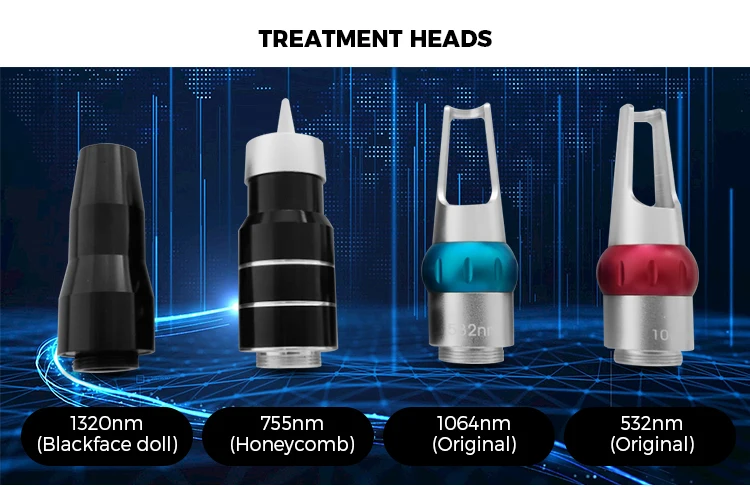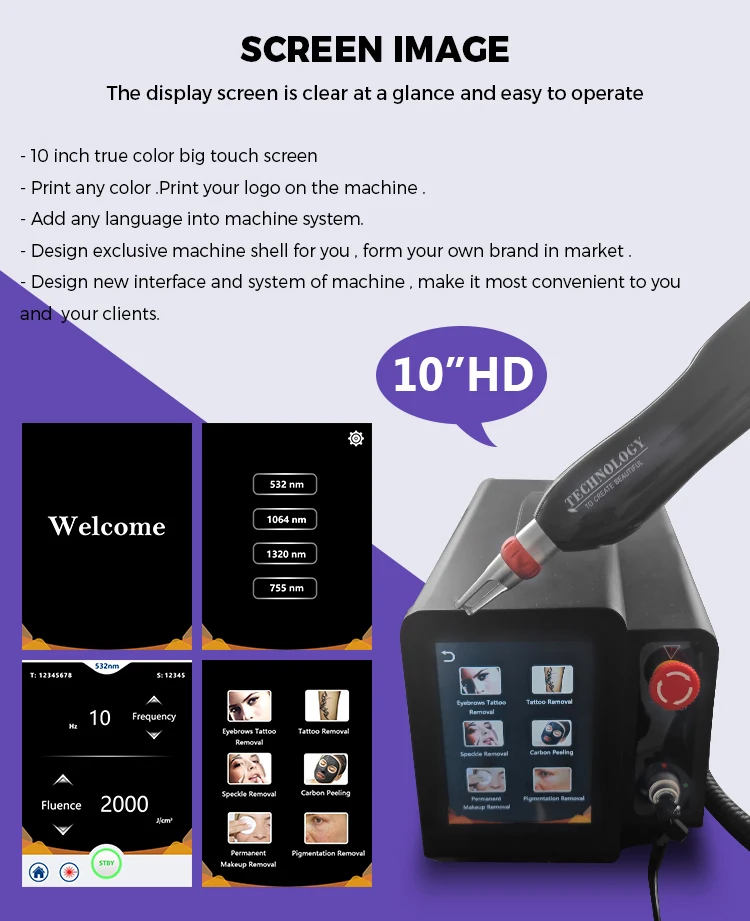



Pico laser machine tattoo removal 532nm 1064 ND-YAG
Introduction to Pico Laser Technology
Pico laser technology has revolutionized the field of dermatology, especially in the realm of tattoo removal. Unlike traditional Q-switched lasers, Pico lasers utilize ultra-short picosecond pulses to break down tattoo ink into microscopic particles, which the body can then naturally eliminate. This technology provides significant improvements in efficacy, safety, and patient comfort, making it the preferred choice for many dermatologists and cosmetic professionals.
How Pico Lasers Work: Understanding the Science
At the core of the Pico laser’s operation is its ability to deliver extremely short bursts of energy—one trillionth of a second (a picosecond). These pulses create a photoacoustic effect, where the energy is absorbed by the tattoo ink, causing it to shatter into tiny particles. The shorter pulse duration ensures that the surrounding skin tissue absorbs less heat, reducing the risk of thermal damage and enhancing the overall safety of the procedure.
The Pico laser typically operates at different wavelengths, with 532nm and 1064nm being the most common for tattoo removal:
1. 532nm Wavelength: This wavelength is particularly effective for removing tattoos with red, yellow, and orange pigments. The 532nm wavelength is absorbed well by these colors, making it ideal for lighter and brighter tattoos.
2. 1064nm Wavelength: The 1064nm wavelength is absorbed by darker tattoo pigments, such as black, blue, and green. This wavelength penetrates deeper into the skin, making it effective for treating tattoos that have faded or have been previously treated.
Advantages of Pico Lasers for Tattoo Removal
The Pico laser’s advanced technology offers several advantages over traditional tattoo removal methods:
1. Enhanced Efficacy: Pico lasers can break down tattoo ink more effectively than older laser technologies. The ultra-short pulse duration allows for more efficient ink fragmentation, leading to better clearance of the tattoo with fewer treatment sessions.
2. Reduced Risk of Scarring: Due to the minimal heat generation and precise targeting of the tattoo ink, Pico lasers significantly reduce the risk of scarring. This is particularly important for patients concerned about the long-term appearance of their skin after tattoo removal.
3. Faster Recovery: Patients typically experience a faster recovery time with Pico laser treatments. The reduced thermal damage to the surrounding skin means that the healing process is quicker, with less downtime between sessions.
4. Versatility: The ability to switch between different wavelengths allows the Pico laser to target a wide range of tattoo colors effectively. This versatility makes it suitable for removing multicolored tattoos, which can be challenging with other laser systems.
5. Comfort: Pico laser treatments are generally less painful than traditional methods. The quick pulses cause less discomfort during the procedure, and the reduced heat minimizes the risk of post-treatment inflammation.
The Role of 532nm and 1064nm ND-YAG Lasers in Tattoo Removal
The 532nm and 1064nm ND-YAG lasers are the most commonly used wavelengths in Pico laser systems for tattoo removal, each offering specific benefits depending on the tattoo’s color and depth:
532nm Wavelength
The 532nm wavelength is particularly effective for removing tattoos with red, yellow, and orange pigments. These colors are typically found in brighter and more colorful tattoos, which can be challenging to remove with other wavelengths.
1. Targeted Removal of Lighter Colors: The 532nm wavelength is absorbed well by lighter tattoo pigments, allowing for targeted removal without affecting the surrounding skin. This precision ensures that only the tattooed area is treated, minimizing the risk of damage to the surrounding tissue.
2. Effective on Superficial Tattoos: The 532nm wavelength is most effective on tattoos that are closer to the surface of the skin. This makes it ideal for newer tattoos or those that have not been previously treated.
3. Reduced Risk of Hyperpigmentation: Due to its shorter wavelength, the 532nm laser has a lower risk of causing hyperpigmentation in the treated area. This is particularly important for patients with lighter skin tones, who may be more prone to pigmentary changes after laser treatment.
1064nm Wavelength
The 1064nm wavelength is the gold standard for removing darker tattoo pigments, such as black, blue, and green. These colors are more common in older tattoos and those that have undergone previous removal attempts.
1. Deep Penetration: The 1064nm wavelength penetrates deeper into the skin, making it effective for removing tattoo pigments that are located in the dermal layer. This is particularly important for older tattoos, where the ink has migrated deeper over time.
2. Safe for All Skin Types: The 1064nm wavelength is safe for all skin types, including darker skin tones. Its deeper penetration reduces the risk of post-inflammatory hyperpigmentation, making it a versatile option for a wide range of patients.
3. Effective on Resistant Tattoos: Tattoos that have previously been treated with other laser systems may develop resistance to treatment. The 1064nm wavelength can overcome this resistance, providing effective clearance of stubborn tattoo pigments.
Comparative Advantages of Pico Laser Over Q-Switched Lasers
Traditional Q-switched lasers were once the standard for tattoo removal, but Pico lasers have largely supplanted them due to several key advantages:
1. Shorter Treatment Duration: Pico lasers require fewer sessions to achieve the desired results. This is due to the more efficient ink fragmentation provided by the shorter pulse duration, which allows for faster clearance of the tattoo.
2. Improved Patient Comfort: Patients often report less discomfort during Pico laser treatments compared to Q-switched lasers. The ultra-short pulses cause less heat buildup, reducing the sensation of pain during the procedure.
3. Lower Risk of Side Effects: Pico lasers have a lower risk of side effects, such as blistering, hyperpigmentation, and scarring. This is due to the precise targeting of the tattoo ink and the reduced thermal damage to the surrounding tissue.
4. Versatility in Treating Multicolored Tattoos: While Q-switched lasers are effective at removing certain colors, they often struggle with multicolored tattoos. Pico lasers, with their multiple wavelengths, can treat a broader spectrum of tattoo colors, providing more consistent results across different tattoo types.
Patient Experience and Expectations
For patients considering Pico laser tattoo removal, understanding the process and setting realistic expectations is crucial:
1. Number of Sessions: While Pico lasers are more efficient than traditional methods, multiple sessions are still required to achieve complete removal. The exact number of sessions depends on factors such as the size, color, and age of the tattoo.
2. Pain and Discomfort: Pico laser treatments are generally less painful than other methods, but some discomfort is still expected. Most patients describe the sensation as similar to snapping a rubber band against the skin.
3. Post-Treatment Care: Proper post-treatment care is essential for optimal results. Patients should avoid sun exposure, keep the treated area clean, and follow their provider’s instructions to minimize the risk of complications.
4. Results: Results vary depending on the tattoo’s characteristics and the patient’s skin type. While many tattoos can be completely removed, some may leave behind faint traces or a “ghost” image, especially if they contain resistant pigments.
Clinical Studies and Evidence
Numerous clinical studies support the efficacy and safety of Pico lasers for tattoo removal. Research has shown that Pico lasers can achieve faster and more complete clearance of tattoos compared to Q-switched lasers, with a lower incidence of side effects.
One study published in the Journal of Cosmetic and Laser Therapy demonstrated that patients treated with Pico lasers achieved significant clearance of their tattoos after just three sessions, compared to five or more sessions with Q-switched lasers. Another study in Dermatologic Surgery found that Pico lasers were particularly effective at removing resistant pigments, such as blue and green, which are notoriously difficult to treat.
Conclusion: The Future of Tattoo Removal
Pico laser technology, with its use of 532nm and 1064nm ND-YAG wavelengths, represents a significant advancement in tattoo removal. Its ability to effectively target a wide range of tattoo colors, reduce the risk of scarring, and provide faster results makes it the preferred choice for both patients and practitioners.
As the technology continues to evolve, we can expect further improvements in efficiency, safety, and patient comfort. Whether for those looking to remove a tattoo completely or fade it for a cover-up, Pico lasers offer a reliable and effective solution that stands at the forefront of cosmetic dermatology.
This description covers various aspects of Pico laser tattoo removal technology, focusing on the benefits of using the 532nm and 1064nm wavelengths. If you need further customization or additional details on any specific aspect, feel free to ask!
Product Description
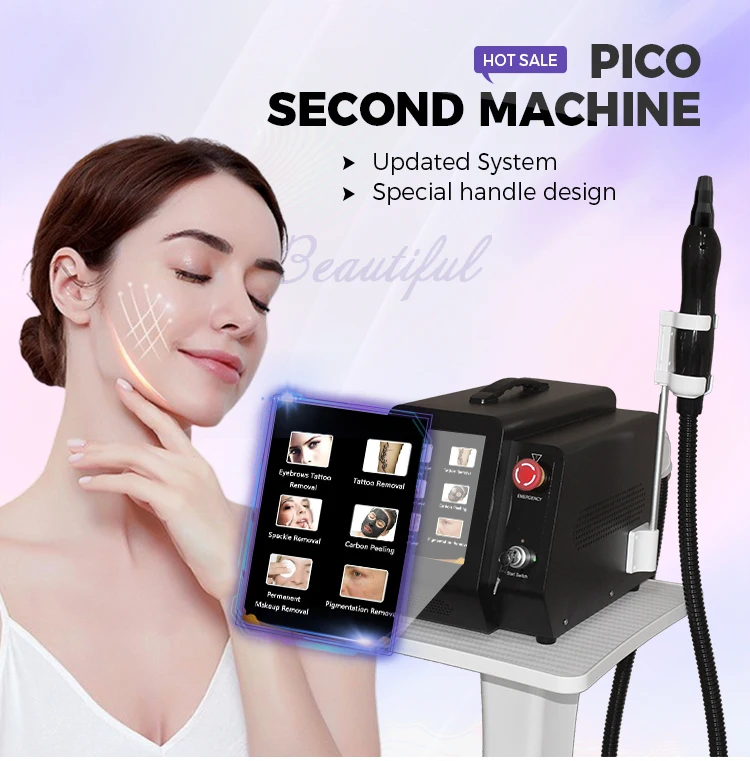
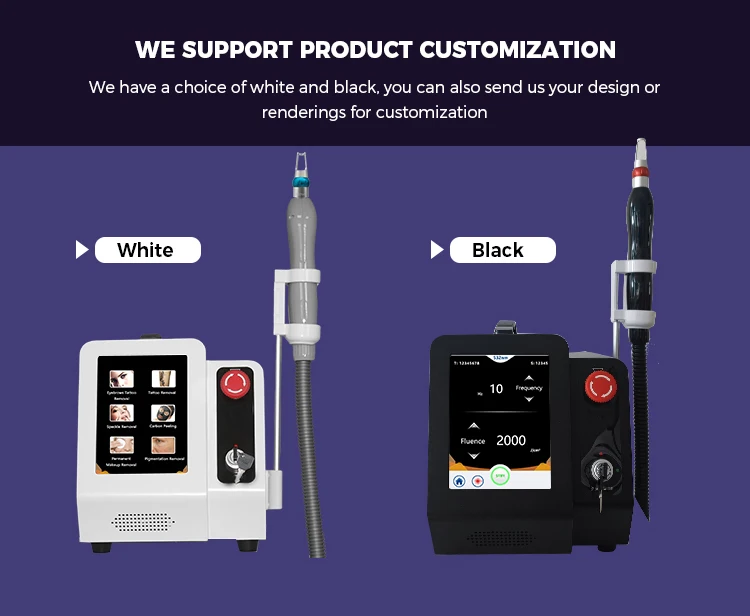
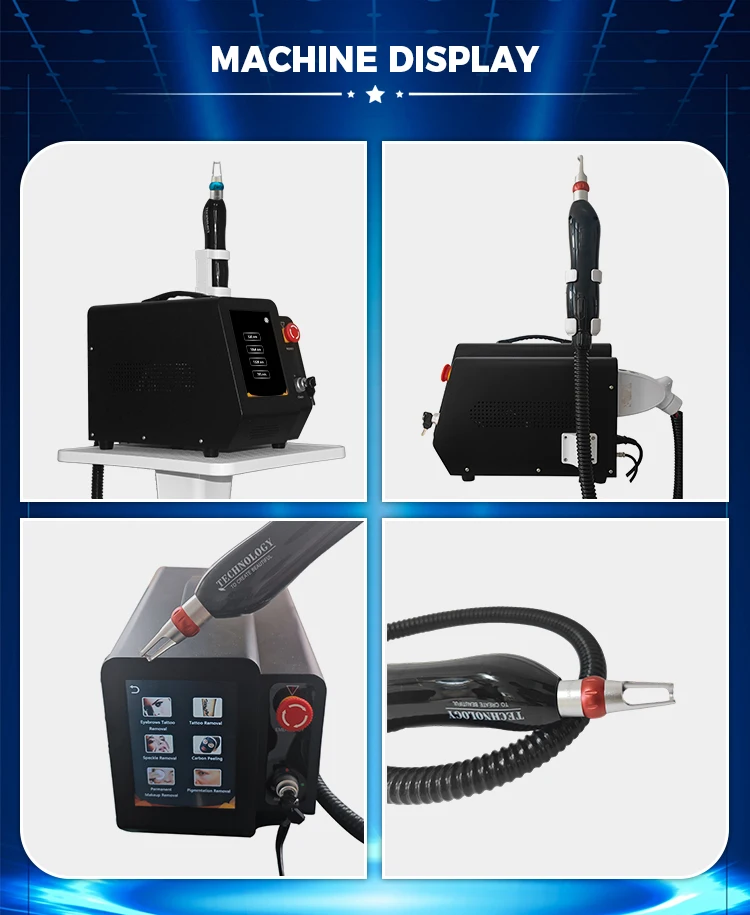
Machine Advantage
Pico laser Advantages Compared with the Q Switch ND-Yag laser :
At Picosecond laser pulse width, the generated photo-mechanical blast target pigment particle, making its volume expansion
instantaneously and resulting in the breakup of the target into micro-particles, which is much easier for phagocytes to clear.
Q-switch laser has a pulse width of 5ns or more, its photo-mechanical blast is not efficient compared to Picosecond laser, it
creates large particles, and with long pulse width, scattering energy goes toward surrounding tissue, resulting in risks of
thermal damage. Therefore, Picosecond laser provides more effective and safe treatment than Q-switch laser.
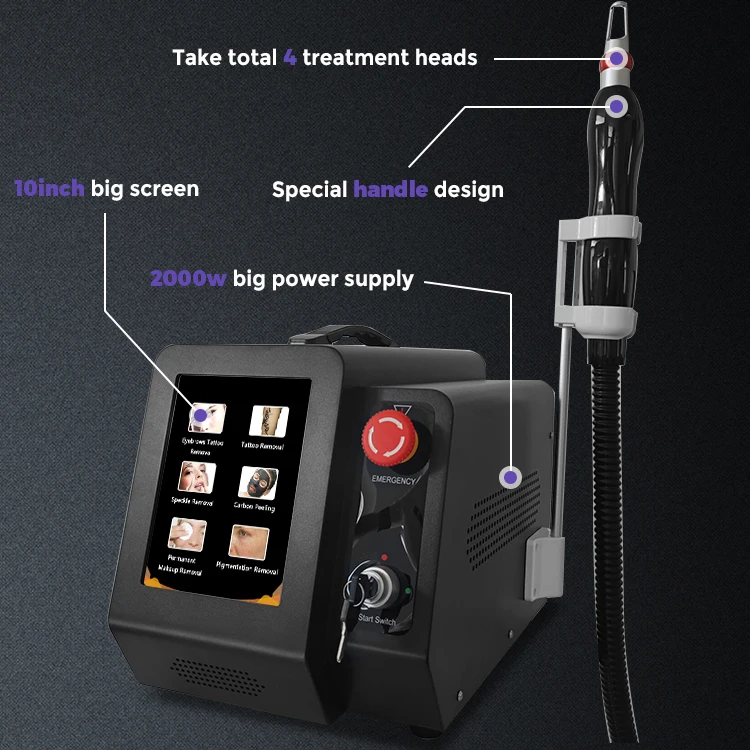
Specification
| Light Source | Portable Picosecond Laser |
| Wavelength | 1064nm, 532nm, |
| Output Energy | Single Pulse: 532nm 400mj; 1064nm 800mj Single Pulse: 532nm 800mj; 1064nm 1600mj |
| Energy Density(Max) | 1064nm: 15.0; 532nm:6 |
| Pulse Duration | 2000PS |
| Repetition Rate | 1-20hz adjustable |
| Spot Size | 2-10mm adjustable |
| Light Guide Beam | 650nm Red Light |
| Cooling System | Closed Cycle Water to Air Heat Exchanger |
| Controlling System | 10.4 Inch TFT color touch screen |
| Power Requirement | 220V,10A, 50/60HZ |
| Note | Technical data changed will not inform specially |
Handle Details
